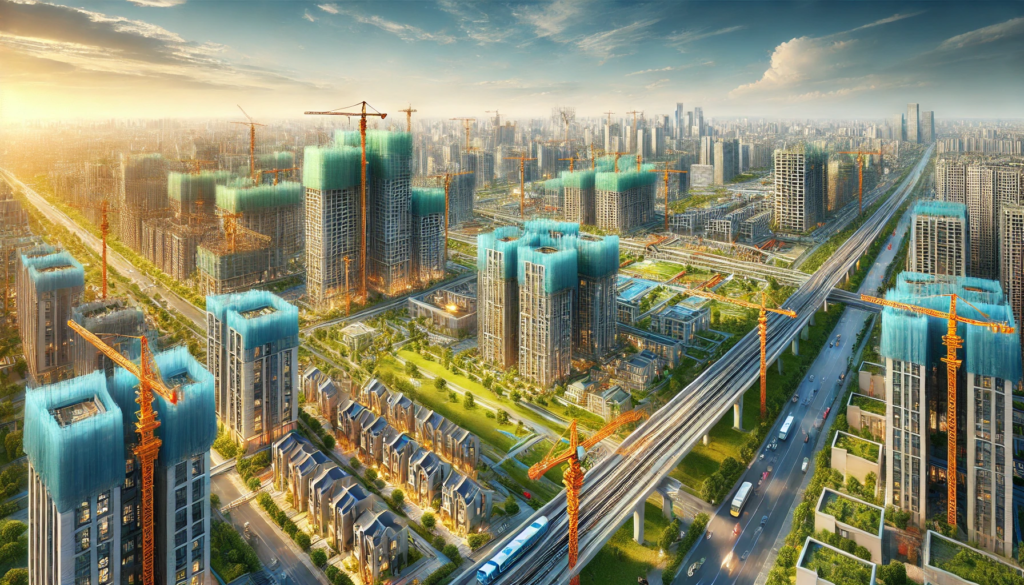Goa, Lucknow Stand Out as Emerging Real Estate Hubs
Arijit Bose December 12, 2024
A Rapidly Growing Market
Tier-II cities, including Lucknow, Faridabad, Vrindavan, Chandigarh, Ludhiana, Bhopal, and Dehradun, have become the focal points of this real estate boom. These cities are seeing rapid growth due to strong infrastructure development, enhanced connectivity, and a rising demand for high-quality residential options. The construction of new motorways, metro networks, and other critical infrastructure projects are fueling both investor interest and consumer demand.
Neeraj Sharma, Managing Director of Escon Infra Realtors, affirms that Tier-II cities are emerging as key growth drivers for the Indian real estate sector. He highlights Lucknow’s exceptional development, noting that improvements in connectivity and government-led initiatives have played a significant role in accelerating the city’s real estate market.
Manit Sethi, Director of Excentia Infra, points to Dehradun as a prime example of this transformation. With a price surge of 14%, Dehradun is attracting homebuyers due to its unique blend of urbanization and natural beauty. “The city’s appeal lies in its ability to offer a high quality of life while being surrounded by picturesque landscapes,” Sethi adds.
The Promise of High ROI and Affordability
One of the main factors driving interest in Tier-II cities is the affordability they offer. With land prices still lower compared to Tier-I cities, developers can launch large-scale projects without the sky-high costs typically associated with metro areas. For investors, this means the opportunity for high returns on investment in both residential and commercial real estate.
Mohit Goel, Managing Director of Omaxe Group, emphasizes that Tier-II cities are particularly attractive to homebuyers looking for a balance of affordability and lifestyle. These cities are becoming a haven for those seeking premium living at a more accessible price point. Developers are responding to this shift by launching upscale residential projects that cater to this growing demand for high-end living spaces.
Piyush Kansal, Executive Director of Royale Estate Group, concurs, noting that the rise in housing prices across Tier-II cities reflects the increasing preference for locations that offer better infrastructure and improved quality of life. He asserts that homebuyers are now prioritizing cities that promise an elevated lifestyle without the exorbitant costs of Tier-I metro areas.
Specific Markets Seeing Growth
While many Tier-II cities are experiencing rapid growth, certain locations stand out due to unique factors contributing to their real estate boom.
Goa, for instance, is experiencing a surge in demand driven by key infrastructural developments like the Mopa Airport connection road, the Zuari Bridge, and the extension of NH-66. According to Vansh Kataria, co-founder of Tirasya Estates, Goa’s real estate market is growing at an unprecedented rate, with property prices now crossing Rs 10,000 per square foot. This indicates that Goa is becoming a major real estate hub, attracting both lifestyle buyers and investors seeking high-quality living spaces.
Lucknow, a city with a rich cultural heritage and growing economic potential, is attracting both investors and homebuyers due to its diverse housing inventory, which caters to both premium and budget markets. The city’s evolving infrastructure and government-backed initiatives are making it a magnet for real estate development, further accelerating its growth in the sector.
Transformation Beyond Residential Real Estate
The growth in Tier-II cities is not limited to residential real estate. These cities are becoming emerging commercial centers as well, with expanding economic activity and business opportunities. As Siddharth Katyal, CEO of Bhumika Group, explains, “Tier-II cities are becoming independent engines of economic and lifestyle transformation, paving the way for balanced and sustainable urban development.” This is especially true in cities like Bhopal and Chandigarh, which are seeing an influx of corporate offices, retail spaces, and industrial hubs.
This commercial transformation is complemented by the rise of new lifestyle hubs, which are attracting residents and businesses alike. The development of parks, shopping centers, entertainment zones, and world-class healthcare facilities is further enhancing the appeal of Tier-II cities as comprehensive living and working environments.
Sustainable Growth in Tier-II Cities
As the demand for Tier-II cities grows, industry leaders stress the importance of sustainable development. Piyush Kansal highlights that sustainable growth approaches are key to meeting the evolving needs of these dynamic communities. The focus on balancing urbanization with environmental preservation is crucial for maintaining the livability of these cities as they grow.
The decentralization of development away from crowded Tier-I cities is another key trend driving growth in Tier-II cities. This shift allows for more balanced, sustainable growth, reducing the pressure on metropolitan areas while providing new opportunities in less congested regions.
Prospects for the Future
With the ongoing emphasis on infrastructure development and the sharp increase in housing prices, Tier-II cities are poised to become the next major growth frontier for India’s real estate sector. The trend toward decentralized urbanization is expected to continue, with these cities evolving into vibrant, self-sustaining economic and lifestyle hubs.
As these cities attract more investment, both residential and commercial real estate markets are expected to thrive, offering compelling opportunities for developers, investors, and homebuyers. The increasing emphasis on connectivity, affordable luxury, and quality living will continue to drive demand for real estate in Tier-II cities, making them central to the future of India’s urban and economic development.
In conclusion, Tier-II cities are not just emerging as a real estate market trend; they are rapidly becoming the next frontier in India’s real estate growth story. These cities offer a combination of affordability, infrastructure development, and a high quality of life that make them attractive alternatives to the crowded Tier-I cities. With continued investment and sustainable development, Tier-II cities will undoubtedly play a crucial role in shaping the future of India’s real estate sector.








